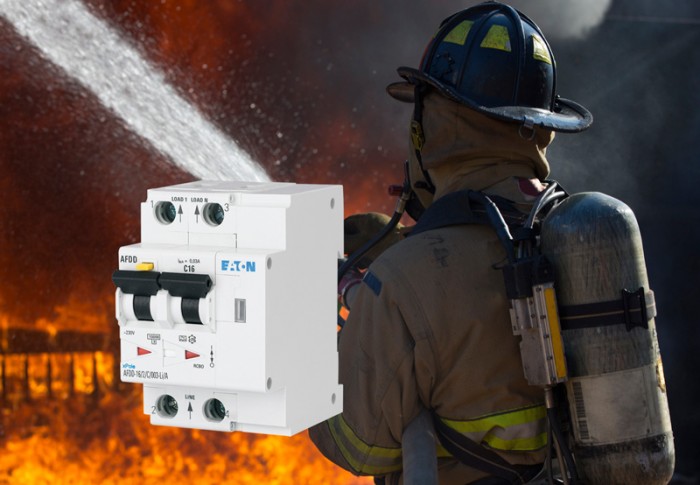Eaton’s new Arc Fault Detection Device helps eliminate risk of fires by arc flashes

Photo by Eaton Corporation
Eaton has launched an Arc Fault Detection Device (AFDD) to protect people and property against fires caused by arc flashes. The power management company’s new device detects high frequency patterns on an electrical circuit that indicate an imminent arc flash and activates a trip switch to eliminate the risk.
In addition to its AFDD capabilities, the new device incorporates a residual current device (RCD), short-circuit and overload protection to provide an all-in-one solution that is cost-effective, compliant, robust, reliable and easy to install. The device is expected to attract particular interest from the residential sector, including multi-occupancy buildings such as care homes and shelters, where the consequences of an arc fault could be catastrophic.
Alexander Jellenigg, product marketing manager at Eaton, said: “The consequences of an arc fault can be severe for any building, and particularly in highly occupied residential accommodation, where a large number of people can be endangered very quickly. The arc fault detection device we are introducing minimises risk by detecting and responding to abnormal signals. What’s more, it does so with a high degree of accuracy in order to significantly reduce nuisance trips.”
Arc faults, which are typically triggered by damaged cables, plugs or terminals, pose an immediate danger to people in the vicinity as they cause damage to electrical infrastructure and can easily ignite a fire. It is estimated that at least 25 per cent of fires are caused by an electrical failure that has triggered an arc fault.
Safe and swift detection of an arc fault is essential, and conventional RCDs and miniature circuit breakers (MCBs) are usually incapable of detecting those arcs.
Eaton’s AFDD offers fast detection with high accuracy, which is essential in minimising nuisance tripping. The device is designed to accurately differentiate genuine risk from other high-frequency signals that commonly occur in domestic environments. To further improve detection quality, Eaton recommends that devices are positioned close to the potential sources of an arc. Additionally, a cross-talk test ensures that the AFDD trips when a relevant signal is detected.
The global requirements for AFDDs were formally established for the first time in 2013, when the International Electrical Commission introduced the IEC 62606 standard. The standard stipulates that AFDDs should trip on detection of any arc of 100 joules or more and that, for very high arc currents, the trip should occur within 120 milliseconds of the detection.
The AFDD is the latest addition to Eaton’s portfolio of products designed to reduce the risks associated with arc faults. These products form part of a wide range of life safety technologies designed by Eaton to protect people, property and reputation, while ensuring minimum disruption to the activities of those who occupy buildings.
For more information, please visit http://www.eaton.eu.
News Categories
- » NEWS HOME
- » Automation & Robotics
- » Industry 4.0
- » Material Handling
- » Sensors
- » Quality & Testing
- » Machine Vision
- » Laser & Optics
- » Metalworking
- » Motion Control & Drives
- » Hydraulics & Pneumatics
- » Process Industry
- » Renewable Energy
- » Agriculture
- » Home & Office Furniture
- » Environmental Tech




